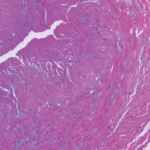Risks for large-vessel involvement for those with cranial GCA include smoking, bruits at diagnosis and transient ischemic attack before the GCA diagnosis.
The left subclavian artery is the most high-yield vessel to examine when there’s suspicion of large-vessel GCA, Dr. Manno said.
“In patients with vascular risk factors such as coronary artery disease, hypertension or aortic murmurs, this maybe a high-yield population to follow longitudinally for large-vessel complications,” she said.
Other Problems That Can Arise
Venous thrombosis is “not uncommon” in GCA, with the greatest risk at a year after diagnosis, then tapering but remaining a significant risk compared to those without GCA, she said.1
The risk of infection in GCA is greatest in the first six to 12 months after diagnosis, and GCA patients are more likely to have septic shock and gastrointestinal infections, such as colitis. Risk factors for infections are older age and diabetes. Pneumocystis jiroveci infection is rare—a 1–6% incidence—but preventable.
Temporal artery biopsy is the gold standard for a GCA diagnosis, but there is always a risk of a “dreaded false negative,” Dr. Manno said. To minimize this risk, samples should be 1.5 cm to 3 cm, and should be done as soon as possible because treatment with steroids can influence the findings.
“In general, the highest yield seems to be a two-week window after you start treatment,” she said.
In cases in which the size of the sample was not adequate, a biopsy of the other side might be needed, she said.
Could imaging be a good alternative? Ultrasound of the temporal artery has its problems—it’s highly operator dependent and the studies testing its value are heterogeneous, Dr. Manno said. Meta-analyses have found its sensitivity to be 75% and 68%, and its specificity to be 83% and 91%.2,3
MRI, she said, while showing “great promise” in this area, is expensive, exposes patients to gadolinium, and its availability can be limited.
Treatment
Glucocorticoids are the mainstay treatment for both GCA and PMR, but methotrexate can play a role; it has been found to lower relapse risk and steroid use.
“The ACR/EULAR guidelines were very careful not to make the universal recommendation for methotrexate but encourage very careful consideration for an individual high-risk patient,” she said. “To me, a high-risk patient would be a poorly controlled diabetic who is obese and has disordered sleep. … I would think about methotrexate for that patient.” She also would consider it in a patient with a high ESR and frequent relapses, who would require repeated increases in their steroid dose.


